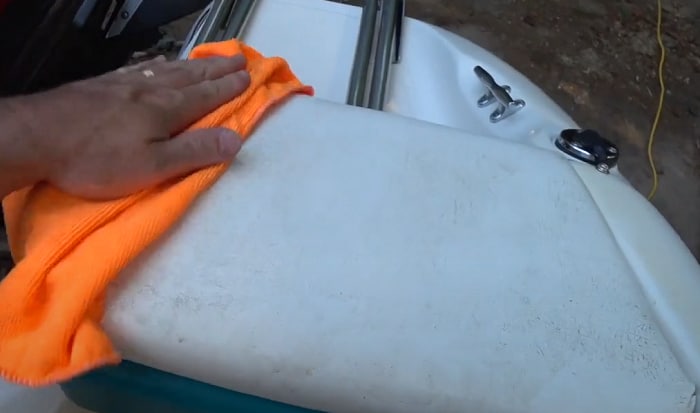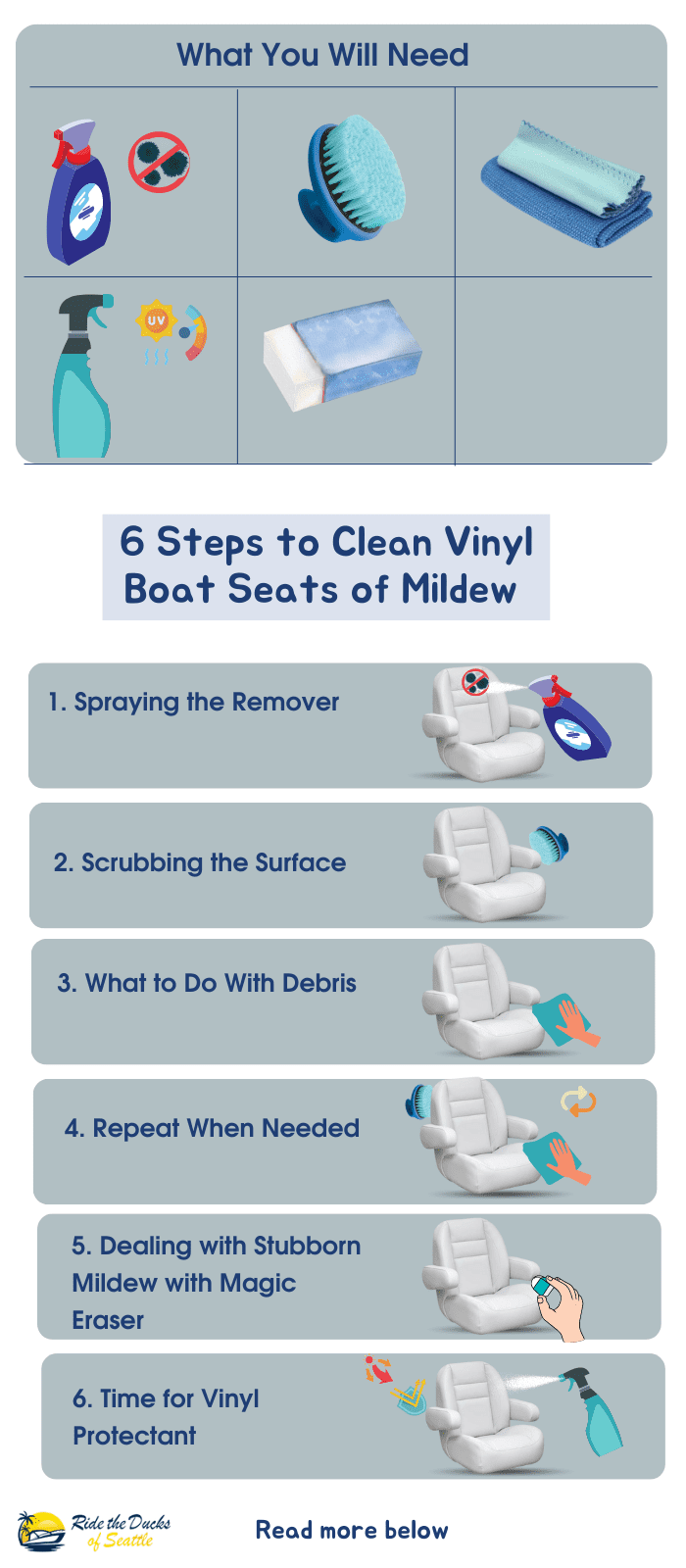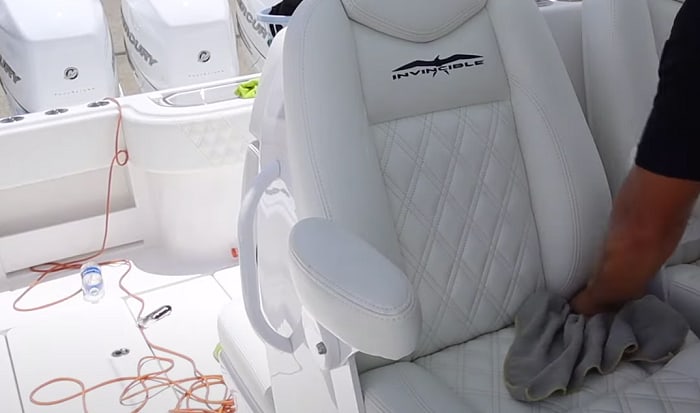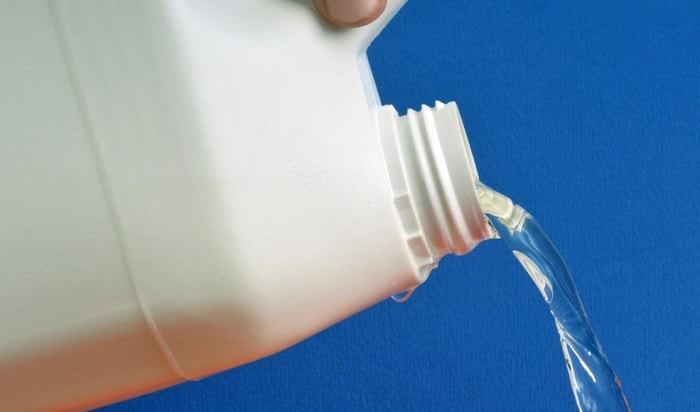Sailing offers a lot of fun and adventures for boaters. However, the journey that you take with your boat means vulnerability to moisture. This element will be one of your concerns in terms of maintenance.
You’ll likely need to know how to clean vinyl boat seats of mildew formed because of moisture. As expected, wiping is done, but you must keep in mind that you don’t harm the vinyl seats.
Some tools and safe cleaners will help you eliminate and even prevent mildew from dominating the boat seats. Read on to know the best way to defeat mildew.
Table of Contents
What You’ll Need
There are different types of boats, but most manufacturers choose vinyl for the seats. It’s because this material is tough enough to withstand wet conditions. As you know, boats are always exposed to water and other strains that are related to it.
Cleaning and getting rid of mildew on vinyl boat seats can be done manually. But you have to collect things that help you achieve a desirable result. They don’t cost much; so, what you’ll have to spend a lot is your time and effort on cleaning.
- Mold and mildew remover (must be bleach-free)
- A soft brush (the one made of nylon will do)
- Microfiber cloth
- Marine spray with UV protectants
- Magic eraser
Bleach on Vinyl? Aye or Nay?
It can’t be denied that bleach is a powerful cleaner. Among other things, you can also use it to wipe away mold and mildew. However, you must know that some parts of your boat will negatively react, specifically, the vinyl. You may wonder why.
Bleach tends to take away the vinyl’s oil which is vital for the material’s longevity and water resistance. This substance can also destroy the stitching that holds the seats together. After bleach is applied, you’ll just find them disintegrating.
Nothing lasts forever, so is vinyl. But you can still work on prolonging its lifespan. One thing that you can do is not use bleach.
You always have the prerogative to find safe cleaning options like CLR Mildew Bleach-free Stain Remover, Moldex Biodegradable Mildew Remover, and IOSSO Mildew Stain Remover.
They are free of bleach or chlorine as they are carefully formulated. You can check the ingredients to ensure that the cleaner won’t be destructive on the vinyl seats.
Step-by-Step Guide
1. Spraying the Remover
You can start spraying the remover once you have all the needed things on hand. It must be done in full coverage. So, don’t miss the gaps and seams as mildew can also develop in these areas.
Give the cleaner some time to work its wonders. Check the label for the recommended time. It usually needs five minutes or more for stubborn stains. Let it sit longer if necessary to break down the mildew, and it will be easier for you to clean.
2. Scrubbing the Surface
After giving the mildew remover enough time, you can start scrubbing the vinyl seats. Part of being careful is using a soft brush like the one with nylon bristles. See to it that you don’t mislay scratches or some damage on the surface.
If you picked a mildew remover that works like magic, you don’t have to scrub hard to eleminate the stain. You may remove the mildew but some debris can be swept with ease. When scrubbing, focus on nooks and crannies too.
3. What to Do With Debris
Debris will be likely seen on sections with serious mildew infestation. Simply wipe them out to make the vinyl seats spick and span! It would be helpful if you should use a microfiber cloth in doing the job. It’s the kind of fabric that doesn’t tear up over vinyl.
Again, don’t forget about narrow sections as they also need to be cleaned even though they’re a bit hidden. Prepare more than one piece of microfiber cloth. The number that you may need depends on the seats’ color and their condition.
4. Repeat When Needed
When the mildew is thick, you will need to repeat scrubbing and wiping not just twice; but multiple times. Again, try to be good with your judgment on which area you need to work on meticulously.
The mildew will be gone after cleaning it the second time around in some cases. But you still need to double-check if it’s thoroughly cleaned. On the contrary, some boaters may be on the point of exhaustion, as they’ve repeated many times but the mildew is still there.
You don’t have to give up as there’s another way of eliminating the mildew. It can be called your ‘last resort’ as it will dismiss the stubborn mildew for good.
5. Dealing with Stubborn Mildew with Magic Eraser
Magic eraser sponges contain special cleaners that are capable of dealing with stubborn mildew. You may skip on tedious scrubbing when using it. Thus, you’ll be relieved in exerting a lot of effort over hard-to-remove mildew.
This eraser needs to be wet before applying. Fortunately, it has a size that will fit into the edges of the vinyl seats. A couple of passes would lead to the desired result, which is the disappearance of mildew.
You don’t have to press hard when applying a magic eraser, unlike scrubbing. An idea to use it directly and skip the cleaner may have popped up in your mind. In some cases, you don’t need its power to get rid of thin mildew.
6. Time for Vinyl Protectant
Wiping away mildew and stain is not the last part because it’s best to give your vinyl seat protection. Considering this step is like giving your best shot for the sake of maintenance.
A vinyl protectant can give the seats a fantastic appearance while it delivers protection against harsh UV rays. The best ones you can find in the market are 303 Marine UV Protectant for Vinyl, Marine 31 Vinyl Protectant, and 3M Marine Vinyl Protector.
Removing Mildew on Vinyl Seats Using Household Products
If you have some time to spare, you can DIY remove mildew on vinyl seats using household products. You need to be patient and put effort rather than just buying a mildew remover.
As long as you know the tricks, you can remove mildew on your vinyl seats with some DIY solutions. Making it on your own will ensure a non-toxic formula. The best part is that you don’t have to spend more since you can find the ingredients inside your house.
Things that can help you:
White vinegar, liquid soap, club soda, and warm water
These ingredients are safe for vinyl and other sensitive surfaces. To create a solution out of them, you just commence with mix and match.
When you have white vinyl seats, make a mixture of 50% water and 50% white vinegar. This combination will also help you restore the color and shine of the vinyl.
The exact ratio can be applied with warm water and liquid soap. Spraying them on the vinyl can break mildew and stain. Club soda can be added to these two mixtures or you may use it all alone to combine with water.
The mixture that is half club soda and half water is usually for stubborn mildew. When you make this, you’ll end up with a paste-like substance. You may use it on colored seats and let it stay for a while before scrubbing.
How to Prevent Mildew from Developing on Vinyl Seats
To make things easier for you every time you clean the vinyl seats on your boat, you better learn how to prevent mildew from growing. You have to agree with the saying, ‘Prevention is better than cure’. Here are some things that you have to do:
- Always wipe the seat after sailing. Although you can’t see any wet sections, it won’t hurt if you let the towel go through the seams and cracks. Mildew forms because of moisture, so you have to keep the seats dry as much as possible.
- You still have to look out for mildew even though your boat is in storage. Choose a cover that ensures the safety of the interior, including the vinyl seats. You may also check the boat from time to time.
Conclusion
When you know how to clean vinyl boat seats of mildew, they won’t be easily degraded. Some vinyl seats are an expensive investment, so it’s just right to take care of them well. Anyway, maintenance is easy as long as you get an effective product and cleaner.
Aside from proper cleaning, you should also check that the products and things you use won’t harm the vinyl surface.

I am passionate about water sports and technical fields, so combining both makes me interested in making contents about boat accessories. With my partner, we went on many trips and sports games together, which led us to think about how we can spread our joys and passions to many people.




